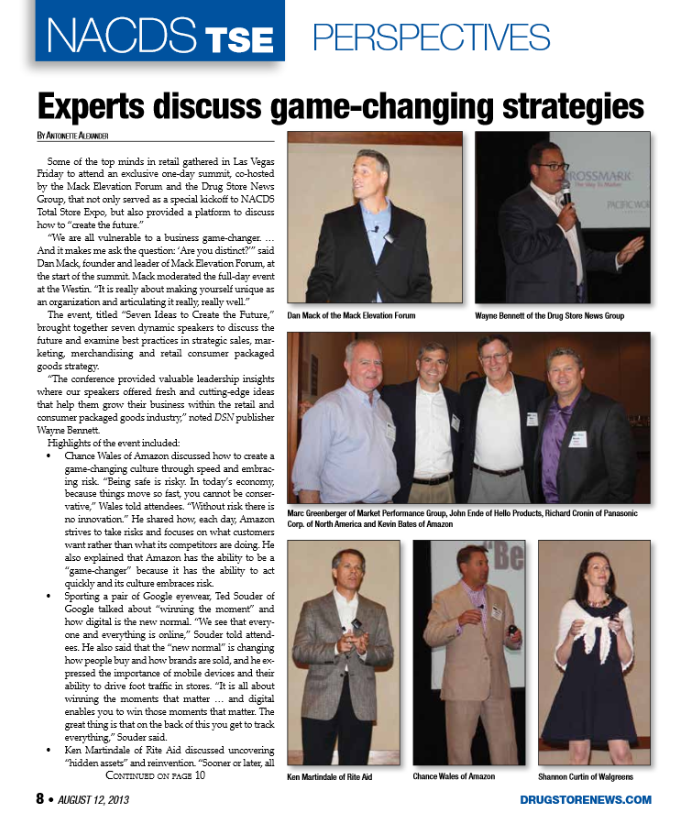
By Antoinette Alexander, Drugstore News.
Experts discuss game-changing strategies perspectives
Continued from page 8 businesses, even the most successful, run into challenges sustaining and achieving growth. Faced with this unpleasant reality, they are compelled to reinvent themselves,” Martindale told attendees. “The ability to pull off this difficult feat and jumping from the maturity stage of one business model to the growth stage of the next is really what separates high performers from those who spend too short of time at the top.” Turning conventional wisdom on its head and embracing change is critical. Martindale discussed how Rite Aid set about creating a new vision, mission and core values, as well as uncovering its “hidden assets.”
• Dennis Moore of Nielsen talked about “big data, smart data.” Moore said that, when he thinks about data and analytics, he judges it by the way it leads to an action. “I always tell the analytic teams at Nielsen that the value in what we do is in the action that it influences,” Moore said. Moore acknowledged that a challenge is that data can be subject to partisanship and there’s often a rush to define it, but he also said that big data can help companies in such areas as identifying untapped opportunities and attracting new buyers. He said that in order to use big data effectively it boils down to leadership. “If you really believe in this, you have to change your internal systems. How do you make decisions? How do you decide how you are going to promote? How you are going to assort? How you are going to market, and is it infused with analytics? And that is everyone’s job [within the company],” Moore said.
NAcDs tse
• Larry Levin of IRI addressed how to win through store localization. “Everybody is going to as many channels as they can to maximize value,” Levin said. In light of this, the dollar store channel is experiencing significant growth — especially among those making more than $100,000 and those under age 35 years — and drug stores are viewed as the new convenience. Levin stressed the importance of understanding the shopper and, for suppliers, understanding that you don’t have to be in every store with your product. In other words, cherry-pick those stores that make the most sense for your product. “Not all neighborhoods and not all stores within a strip mall are created equal. They share a common footprint, but the kinds of people that walk in can be very different, so dare to be different,” Levin told attendees.
• Walgreens’ Shannon Curtin talked about co-creation, innovation and how to drive value. When talking about co-creation, Curtin stressed the importance of opening up the dialogue between both the retailer and supplier to ensure you are on the same road at the same time. “Being the best at co-creation is having this wonderful creative genius, and that starts with transparency and having these conversations,” Curtin said. Curtin discussed why it is important for suppliers to co-create with Walgreens and how the retailer has helped smaller manufacturers successfully enter the market. “The value of working together is bigger than the value of working alone,” Curtin said. One example of co-creation that Curtin used was the partnership between Walgreens and DSN to create Beauty University, a training platform for Walgreens’ 26,000-plus beauty advisers.
• Mark Jones of IDEO talked about innovation and creativity. Jones encouraged attendees to observe insights, brainstorm (i.e., the more ideas the better) and make the ideas real (i.e., sketch it, build it and act it out). During his presentation, Jones also gave attendees a behindthe-scenes look at how IDEO approached several projects for clients, including the design of Walgreens’ new pharmacy department, which brings the pharmacist out from behind the pharmacy counter to interact with patients.
10 • August 12, 2013 DrugStoreNewS.com

